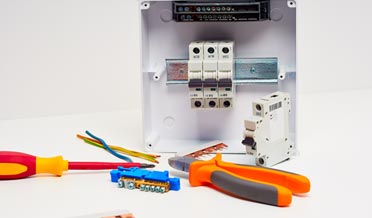Electrical Safety Checklist
Electrical Safety Checklist: 5 Maintenance Tips
As homeowners, we are constantly trying to find ways to make our home safe and comfortable—our “castle.” Yet the risk of home fires and electrical injuries are real; every year we hear of thousands of house fires and hundreds of deaths that result from electrical malfunctions. Knowing the source of everyday dangers, the National Fire Prevention Association has produced an electrical safety checklist to help homeowners protect their families.
Do Not Let Things Slide!
If you notice something that is wrong, do not ignore it. This could save a life. If you experience any of the following, call an electrician and correct the source of the problem immediately.
- Do your circuit breakers trip or fuses blow frequently?
- Do you feel a mild shock when you touch an appliance?
- Do you notice discoloration on outlet faceplates? Are outlets warm to the touch?
- Do you smell rubber or a burning odor?
- Do lights flicker or dim?
- Do sparks fly from outlets?
All of these are indications of serious issues that can lead to tragedy; a licensed electrician will be able to diagnose the problem and make repairs.
Take A Look Around
You are always the first line of defense, protecting your family from harm. No one is better prepared to notice anomalies and you will certainly notice things that need to be repaired.
- Electrical Cord Electrical Safety
- Make sure that electrical cords are intact, not damaged, not cracked, and not loose. Damaged cords can lead to both fire and/or shock.
- Do not run electrical cords across well-traveled paths, including doorways. Do not position cords under carpets or rugs.
- Be watchful when young children are in the vicinity of electrical cords. Little ones explore by putting things in their mouth.
- Outlets and Switches Electrical Safety
- Faceplates are very inexpensive, so make sure outlets and switches are covered and undamaged.
- Do not overload outlets by plugging multiple cords into one receptacle. Plugging multiple power bars into one outlet can lead to an overloaded circuit.
- Reduce the risk of shock in kitchens and bathrooms by installing ground-fault circuit interrupters (GFCI) outlets at locations near a water source. A GFCI is a circuit breaker at the outlet that detects the amount of current going from the outlet to the amount of current returning to the outlet. It should be the same. A GFCI can interrupt the current within 1/40th of a second to prevent serious shock.1
- Light Bulb Electrical Safety
- Always use the appropriate lightbulb for the lamp or light. Using a bulb that exceeds the maximum can overheat the lamp.
- Light bulbs placed in proximity to flammable objects should have a shade or globe to prevent overheating objects. The filament in incandescent light bulbs can reach 4,5000 F, hot enough to ignite nearby objects.
- Appliance Electrical Safety
- Buy appliances with approval listing from a testing laboratory, such as UL.
- Only plug one heat-producing appliance—toaster, coffee maker, iron, etc.—into each outlet to prevent overheating.
- Keep Ladders Away from Overhead Power Lines
Have Electrical Safety in your home or business?
Our four decades of experience as a Houston Electrician and contractor AirPro Houston provides you with the skill and expertise to maintain Electrical Safety for your home and business.
We have financing options available with great options with up to 72-month terms with approved credit. Call us today at 281-880-8805 and let us partner with you for all of your electrical repair and installation needs.

1 https://www.osha.gov/electrical/hazards/grounding/gfci
